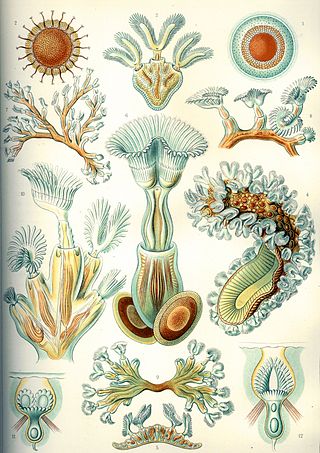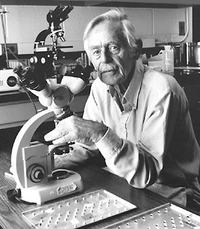Related Research Articles

Bryozoa are a phylum of simple, aquatic invertebrate animals, nearly all living in sedentary colonies. Typically about 0.5 millimetres long, they have a special feeding structure called a lophophore, a "crown" of tentacles used for filter feeding. Most marine bryozoans live in tropical waters, but a few are found in oceanic trenches and polar waters. The bryozoans are classified as the marine bryozoans (Stenolaemata), freshwater bryozoans (Phylactolaemata), and mostly-marine bryozoans (Gymnolaemata), a few members of which prefer brackish water. 5,869 living species are known. At least two genera are solitary ; the rest are colonial.
Dinosaurus is an extinct genus of therapsid of controversial affinities. Its type and only species is Dinosaurus murchisonii. It is only known from a partial snout from the Permian of Russia. Its taxonomic history is intertwined with several other poorly-known Russian therapsids, particularly Rhopalodon, Brithopus, and Phthinosuchus.

Deschampsia is a genus of plants in the grass family, commonly known as hair grass or tussock grass. The genus is widespread across many countries.

Platystrophia is an extinct genus of brachiopods that lived from the Ordovician to the Silurian in Asia, Europe, North America, and South America. It has a prominent sulcus and fold. It usually lived in marine lime mud and sands.

Ernst J Eichwald (1913–2007) was a pathologist known for his pioneering work in tissue transplantation and research on genetic factors that influence the rejection of organ transplantation. Dr. Eichwald, while studying cancer in the 1940s, described the male-specific antigen and helped establish the foundations of transplantation immunology. He organized the first International Transplantation Conference, sponsored by the National Institutes of Health (NIH), in Harriman, N.Y., in 1953; founded and edited the journal, Transplantation Bulletin and its successor, Transplantation, for more than 30 years; and chaired the Transplantation Committee of the National Academy of Sciences from 1955 to 1967. His research played an important role in the development of successful protocols for organ transplantation in humans.
Lunostoma is an extinct genus of bryozoans which existed during the middle Devonian of what is now Germany, precisely from the Gerolstein syncline. It was described by Andrej Ernst, Paul D. Taylor, Jan Bohatý and Patrick N. Wyse Jackson in 2012, and the type species is L. pulchra.
Argentinodictya is an extinct genus of bryozoans which existed in what is now Argentina during the Late Ordovician. It was described by Andrej Ernst and Marcelo Carrera in 2012, and the type and only species is Argentinodictya lenticulata.

Chorispora is a genus of plant in the family Brassicaceae.

Catenicella is a genus of marine bryozoans belonging to the family Catenicellidae. Bryozoans are colonial animals that live in aquatic environments, and Catenicella is no exception. Members of this genus are found in oceans around the world, with a particularly high diversity in the Arctic and Antarctic regions.
Crisia is a genus of bryozoans in the family Crisiidae. Some species are known from the fossil record.
Myrciaria tenella, commonly known as cambuí or camboim, which are also used to describe Myrciaria cuspidata and Myrciaria delicatula; or more specifically jabuticaba-macia, and cambuí-açu, is a species of plant in the family Myrtaceae.

Karl Franzevich Rouillier or Rul'e was a French-origin zoologist, geologist, paleontologist and professor who introduced ideas and approaches to understanding evolution in Russia, questioning the paradigm of the time of species being fixed and unchanging from the time of Biblical Creation.

Disporella is a genus of bryozoans belonging to the family Lichenoporidae.
Tubulipora is a genus of bryozoans belonging to the family Tubuliporidae.
Septopora is an extinct genus of bryozoan belonging to the order Fenestrida. It has been found in Pennsylvanian to Permian beds in North America, South America, Australia, and southwest and east Asia.
Nicholsonella is an extinct genus of bryozoans of uncertain taxonomic placement. Its colonies can take the forms of thick branching masses or branches.
Moyerella is an extinct genus of bryozoan of the family Arthrostylidae, known from the Upper Ordovician and Lower Silurian periods. Its colonies are branching or segmented, generally articulated (jointed). Its autozooecia are short tubes that appear triangular in cross section within the endozone, bending abruptly when reaching the exozone. The autozooecial apertures are round and aligned into diagonal rows, and paired heterozooecia occur between the autozooecial apertures.
Stenodiscus is an extinct genus of bryozoan of the family Stenoporidae, known from the Carboniferous to the Upper Permian periods. Its colonies were large and could be encrusting, massive, or branching, sometimes made of multiple layers of growth over themselves, and usually possessed monticules with abundant large acanthostyles.
Tarphophragma is an extinct genus of Middle and Upper Ordovician bryozoans of the family Halloporidae. Its colonies began from an encrusting base and grew into branching structures. Raised maculae made from mesozooecia and large autozooecia covered the colony's surface, and its autozooecia were arranged in a disorderly pattern. Its interzooidal budding pattern and integrate wall structure distinguish it from other genera.
References
- ↑ Chasmatopora at www.bryozoa.net.
- ↑ Andrej Ernst & Marcelo Carrera (2012). "Upper Ordovician (Sandbian) bryozoan fauna from Argentine Precordillera". Journal of Paleontology . 86 (5): 721–752. doi:10.1666/12-024.1. hdl: 11336/52220 . S2CID 86306266.